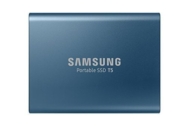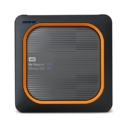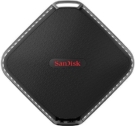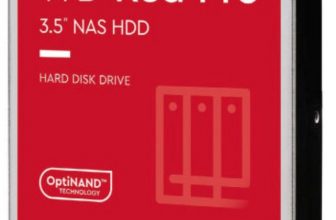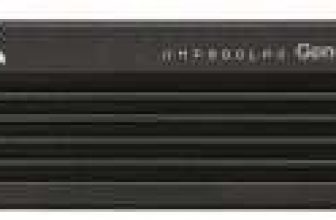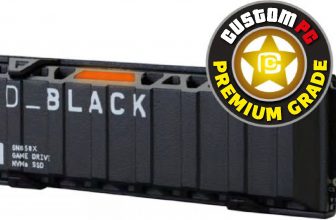Fast external storage options compared
Portable SSDs have become faster and more affordable over the past couple of years. Joel Burgess finds out if they’re still too flashy for your average consumer.
Prior to Samsung releasing its T1 external hard drive, portable solid state drives (SSDs) were a little expensive to be a particularly appealing alternative to portable external hard disk drives (HDDs).
But it’s been a few years since then and the portable SSD market has matured into an appealing category, attracting the efforts of big hard drive players like Western Digital and LaCie, and even sporting a few second or third generation drives from SanDisk and Samsung. The latest external SSDs benefit from some hardware innovations that give sequential read and write speeds of 400-500MB/s – some 100-200MB/s faster than the first generation fast flash drives.
That’s an increase of roughly 25%! While this isn’t quite enough to make RAIDed fast drives obsolete just yet, the traditional, spinning-plate 250MB/s dual HDDs will only be around for another few years at most. What’s perhaps even better for consumers, though, is that this competition is driving prices down, making fast storage something that anyone can have.
Table of Contents
How we tested
The External SSDs and fast USB flash drives were tested in both CrystalDiskMark 5.1.2 and the earlier CrystalDIskMark 3.0.4 in 64-bit mode with five repeats and 500MB file sizes. All benchmarks were performed on a Surface Pro 4 using a USB 3.0 interface.
[table id=16 /]
Samsung T5 Portable SSD Review
High five for Samsung’s new solid state drive.
Samsung’s T1 and T3 drives were some of the first portable SSDs to get the company’s V NAND layering tech, pushing read and write speeds above the 200-300MB/s threshold of traditional flash based storage. While a lot of the market has now caught up and LaCie’s new Rugged SSD is actually even faster, the T5 is still well above average and isn’t as expensive as the top player. While the 437 and 444MB/s sequential Q32T1 read and write speeds are still impressive, the T5 is also exceptionally compact, lining up with the footprint of WD’s SSD offering. The card-sized unit actually manages to pass the 2m shockproof drop test, at least under controlled conditions in Samsung’s lab, competing with some of the durability features of LaCie’s rugged unit. The T5 is barely 10% faster than the T3, so if you can buy the older model at a discount, do so. That said, Samsung’s latest SSD is still competitive when it comes to value, with the 500GB T5 model landing just above WD’s 512GB SSD by about $10.
Verdict
The fastest and best value portable SSDs available.
4.5/5
????Recommended
SAMSUNG T5 Portable SSD 500GB - Up to 540MB/s - USB 3.1 External Solid State Drive, Blue (MU-PA500B/AM)
[wps_separator style=”default” top=”yes” text=”Top” separator_color=”#444″ link_color=”#444″ size=”2″ margin=”15″]
What to look for when purchasing a portable SSD…
Interface
All of the drives tested here are either USB 3.0 or 3.1, but there is no reason Thunderbolt adaptors couldn’t work equally as well for devices aimed at Mac users. Be careful not to buy anything with USB 2.0, as it won’t be able to transfer faster than 60MB/s (practical transfers of around 40MB/s).
Size
SSDs and flash USB drives still have distinct form factors as a matter of habit. Decide if you want a compact portable hard drive shape, or you would prefer to plug in an oversized USB flash drive.
Connection
This is generally related to the interface but the two main connections to be aware of are USB Type-A (the most common USB connection) and USB Type-C. You’ll need to check it’ll be compatible with the ports in the devices you wish to use it with.
SSD vs Flash USB The difference here is largely semantic and historical. SSDs were originally made from DRAM memory chips (what your computer uses as memory), but these days any affordable SSD will be made from NAND Flash technology.
[wps_separator style=”default” top=”yes” text=”Top” separator_color=”#444″ link_color=”#444″ size=”2″ margin=”15″]
WD My Passport SSD Review
Your ticket to speedier storage.
WD’s long since been a dominant player in the portable hard drive space. Although it’s late to the party with its My Passport SSD, this flash drive comes in strong to create genuine competition at the top of the market.
It isn’t quite as fast as Samsung’s T5 getting read and write speeds of 390.1 and 385.4 MB/s in the SSD-oriented sequential Q32T1 speed tests, but the My Passport is only about 10% slower, and is actually faster than the T5 in the older non-queued sequential speed tests. In real-world use, the difference would be unnoticeable. The two are also about the same size; the My Passport is slightly narrower and longer than the T5 and weighs a mere 40g. The My Passport SSD borrows the dual textured exterior of the larger My Passport range and offers both USB 3.1 Type-A and C cables to connect to a range of modern devices.
On average street prices are more for the WD My Passport SSD, but it’s as close a competitor to Samsung’s T5 as we’ve seen.
Verdict
This fast portable SSD is both compact and good value.
4.5/5
????Recommended
WD My Passport Wireless SSD Review
HyperX Savage Review
A slick and speedy drive that could do with a discount.
The metallic red X shaped frame wrapping aroun d the HyperX Savage drive is unapologetically flashy an d makes it clear hat this USB is aimed at gamers. The soft black powdery plastic and the heavy metal alloy combine to give a uniquely weighty and premium feel. The Savage is a flash-based USB drive that keeps up with SSDs in most of the general usage speed tests.
The HyperX Savag uses the USB 3.1 interface through a male Type connection, and has include adapter for USB Type-C. The Savage pushed sequential reads at a respectable 312MB/s and could write sequentially at 211MB/s, which isn’t particularly fast but not significantly slower than the other thumb drive here either. At just 128GB, it is one of the smaller capacities on offer and it’s a little pricey when you consider you can get some of the larger capacity 256GB drives here for a similar price or comparable drives from Kogan for half the price.
Verdict
This USB flash drive is fast, loud and expensive.
3/5
SanDisk Extreme Pro USB 3.1 SSD Review
USB stick it to the man.
While Samsung seems to still have the edge in the portable SSD market, the SanDisk Extreme Pro USB 3.1 Solid State Flash Drive isn’t a bad alternative if you want to stick to the stick form-factor. By calling it a solid state flash drive, SanDisk wants to convey that, even though it takes the form factor of a USB flash drive, it actually has the speeds of a larger SSD.
And SanDisk isn’t lying: the drive pulls sequential Q32T1 read and write speeds of 311.4 and 287.7MB/s in CrystalDiskMark 5, a score that is well above any USB flash drive we’ve tested and beats the SanDisk Extreme 500 by at least 10% across all speed tests. While it’s hardly novel, the retractable USB stick form factor is convenient if you want to carry it in your pocket, and comes with a plastic loop to attach it to your keychain. 256GB is a reasonable capacity and the price isn’t over the top, but if you don’t have to have your SSD attached to your keys, you can get about 30% faster speeds from Samsung’s T5.
Verdict
A compact USB thumb drive that’s as fast as a portable SSD.
4/5
????Recommended
SanDisk Extreme 500 Review
A solid state diamond in the rough.
We gave the SanDisk Extreme 500 a score of 4.5 back in 2016, but its slower read and write speeds drag it down against newer offerings. The flat, diamond-shaped SanDisk Extreme 500 might have been overtaken by a slew of portable SSDs, but its still faster than any dual-HDD drive we’ve seen and far more compact. It’s also still rather thin compared to other portable SSDs, measuring a little over a centimeter thick. SanDisk was one of the first to market the shock- resistant characteristic inherent in SSDs by pitching the Extreme 500 as an ultra portable rugged drive.
This pocket-sized portable drive performs in line with what should be expected from real-world tests of fast flash drives recording sequential read speeds of 335MB/s and write speeds of 283.6MB/s. We found the write speeds dropped to around the 200MB/s mark using the modern Q32T1 sequential speed tests, and the drive hasn’t dropped in price at all since launch.
Verdict
A slightly older offering that’s still speedy and comes at a reasonable price.
3.5/5
SanDisk Extreme 500 Portable SSD 240GB SDSSDEXT-240G-G25
LaCie Rugged Review
Thunderbolt USB-C
Taking tech into the wild.
LaCie’s rugged range has been around for a while, and although you’ve always paid a premium for its Mac-focused portable drives, the company’s new 500GB SSD — the Rugged Thunderbolt USB-C — is even more expensive.
At close to double the price of Samsung’s 500GB T5 portable SSD, it’s a long way from a bargain, but this tough portable storage unit is also pretty bulky when you line it up next to the competition. Weighing in at 400 grams, it’s almost eight times the mass of the T5, more than twice as thick and has close to double the footprint. This additional bulk does afford it extra durability, bundling in a 2m drop resistance, IP54 splash resistance and a 1,000kg pressure durability to make it a good drive for people who need to carry it in unpredictable circumstances. It also happens to be the fastest SSD we have on record here at APC, getting Sequential Q32T1 read speeds of 533.1MB/s and writes at 484.7MB/s.
Verdict
A rugged and super fast portable SSD that will do some damage to your bank account.
3.5/5
